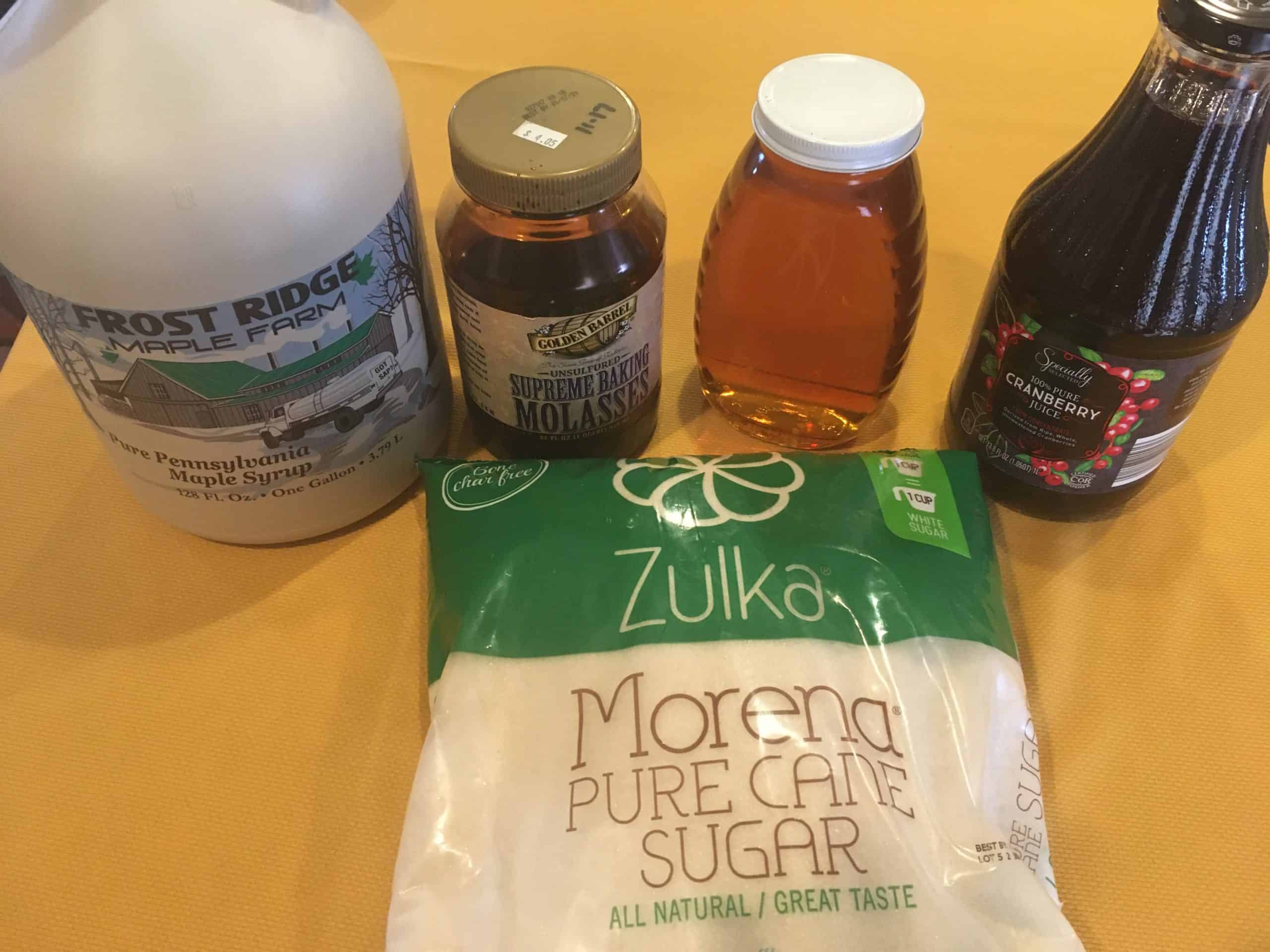This week is Sugar Awareness Week, and I thought it was a good opportunity to explain the differences here, as well as offer some alternatives for how you can reduce your sugar intake.
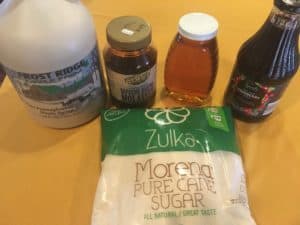 Sugar, regardless of its form, is a simple carbohydrate. Our bodies convert sugar to glucose and then use it for energy. But, there are two kinds of sugars – natural and refined – and they are processed by and affect our bodies in different ways.
Sugar, regardless of its form, is a simple carbohydrate. Our bodies convert sugar to glucose and then use it for energy. But, there are two kinds of sugars – natural and refined – and they are processed by and affect our bodies in different ways.
Disclaimer: The information in this post isn’t intended as medical advice. I researched the topic thoroughly before writing this post, and resources are listed at the bottom of the post. If you have any specific questions about your diet and/or health, please discuss it with your doctor.
Natural Sugars
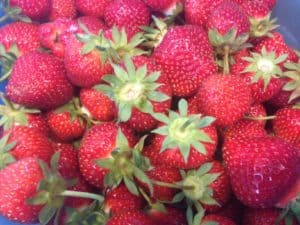 Fresh fruit and 100% natural fruit juices contain natural sugars in the form of fructose, while dairy products naturally contain lactose. The natural sugars and other nutrients found in real fruit and dairy products help keep our bodies healthy and also prevent disease.
Fresh fruit and 100% natural fruit juices contain natural sugars in the form of fructose, while dairy products naturally contain lactose. The natural sugars and other nutrients found in real fruit and dairy products help keep our bodies healthy and also prevent disease.
The digestion process of natural sugars is slower than that of processed sugars, so they also help us feel full for longer periods, and stabilize our metabolism.
Refined Sugars
Refined sugar comes from sugar cane or sugar beets that go through an extraction process, resulting in sucrose (a combination of glucose and fructose.) The resulting products usually include refined white and brown sugars and high-fructose corn syrup.
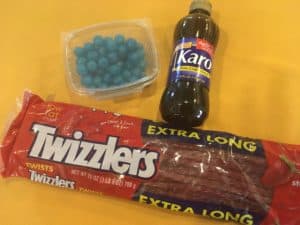 Sugars in this form are digested quickly by our bodies, which causes both insulin and blood sugar levels to spike. Due to its quick digestion rate, you don’t feel full when you are done eating it, and increased consumption is also linked to obesity rates and in turn, higher risks of cancer.
Sugars in this form are digested quickly by our bodies, which causes both insulin and blood sugar levels to spike. Due to its quick digestion rate, you don’t feel full when you are done eating it, and increased consumption is also linked to obesity rates and in turn, higher risks of cancer.
Added Sugars
Any product containing sugars or other caloric sweeteners that aren’t naturally occurring in the food is considered an added sugar. There are over 50 kinds of added sugars commonly used in processed foods, but some of the most common ones include high-fructose corn syrup, cane sugar or juice, maltose, dextrose, rice syrup, molasses, agave nectar, and honey – to name a few.
It’s important to note that some labels are using terms of glucose syrup or fructose in place of high-fructose corn syrup now. In essence, if the company uses a high-fructose corn syrup with 90% fructose in it, they can put “fructose” in the ingredient list and advertise on the front of the label that it is “free of high fructose corn syrup.” Tricky, right?
Are Certain Added Sugars Better than Others?
It’s a great idea to look for unrefined sugars to use for your sweetening needs, but it’s important to note that they are still sugar.
For our white sugar at home, I buy Zulka unrefined white sugar. It doesn’t contain animal bone char as most commercially refined sugars do, and it is minimally processed from freshly-harvested sugar cane.
Other unrefined sugars include agave nectar, cane juice, coconut sugar, date sugar, molasses, maple syrup, brown rice syrup, and honey. Some of these are better for you than others. For example, agave syrup contains more fructose than high-fructose corn syrup, and though raw honey is high in minerals and antioxidants it contains more carbs and calories per teaspoon than standard sugar.
Let’s Talk about Artificial Sweeteners
Artificial sweeteners are something I’m not going to discuss much in this post, but I did want to mention them. The US FDA has approved five artificial sweeteners: saccharin, acesulfame, aspartame, neotame, and sucralose. Additionally, the use of stevia – a low-calorie sweetener – has also been approved.
Animal studies suggest that artificial sweeteners may be more addictive than cocaine. Also, their “safety” is questionable, with long-term effects of use being relatively unknown. I’d rather have the “real” stuff any day of the week, just less of it!
What about Carbs?
Starch is another type of carbohydrate, which is broken down by our bodies into simple sugar and used for energy. Sugar is a carbohydrate too, so doesn’t that mean starch = sugar? It does … but starches are in the “complex carbohydrate” category, and it takes our bodies longer to break them down than it does the simple carbohydrates found in sugar. Since the digestion process occurs more slowly than that of refined sugars, they don’t cause the same sudden spike in blood sugar that is caused by simple carbohydrates.
So, starches are still something to be aware of – but they are treated differently by your body than a chocolate chip cookie, for example.
Ways to Reduce your Sugar Intake
So, now that we covered all the facts about sugar and what kinds there are and why it matters … let’s get to the good stuff. How the heck can you reduce your sugar intake, anyway?
Read Labels & Buy Fewer Processed Foods
The most important thing you can do is buy less processed foods. They are putting a ton of sugar in everything. The last time I tried to buy a box of breakfast cereal, I couldn’t even find one I wanted to buy – due to all the sugar. So, breakfast cereal, pancake mixes, granola bars, candy, cookies, baked beans, sloppy joe mix, canned soups (those are more sodium than sugar, but the same argument applies) … you get the idea.
I’m not suggesting we all start making everything from scratch – I know everyone is busy. But, looking at the labels is a good start – even if it’s buying the “better” of two options, that’s still at least reducing it. And, making some things from scratch doesn’t take as long as you might think!
Drinks
Soda, energy drinks, sports drinks, and fruit drinks combine to account for approximately 44% of the added sugar in the American diet. So, what are some alternatives? Water and green tea are great alternatives. Ways to flavor them naturally include mint and fruit.
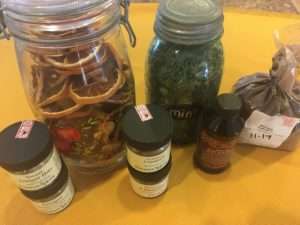 Are you a “sugar-in-your-coffee” person? I used to be! My husband gently broke me of it several years ago, and now I drink my coffee with only a splash of milk. I’ve noticed recently that my “splashes” are getting smaller, I think I may be about ready to graduate to black coffee. (A trick from my grandma: sprinkle cinnamon in with your coffee grounds and it gives you a really nice flavored coffee – without any sugar!)
Are you a “sugar-in-your-coffee” person? I used to be! My husband gently broke me of it several years ago, and now I drink my coffee with only a splash of milk. I’ve noticed recently that my “splashes” are getting smaller, I think I may be about ready to graduate to black coffee. (A trick from my grandma: sprinkle cinnamon in with your coffee grounds and it gives you a really nice flavored coffee – without any sugar!)
We also rarely drink soda in our house. We keep some Coca-Cola in the cupboard for mixing with rum sometimes, but more often than not our 12-pack expires before we drink it all. It’s pretty funny when you grab a can from the pantry in August and it has Santa Claus on it …
My largest weakness when it comes to drinks is fruit juice. First of all, make sure you are buying 100% juice. Then, one trick you can do is water your juice down when you drink it. I’ve done even up to 50% water before and it’s still a really strong juice flavor.
Canned Fruit and Vegetables
If you are buying canned fruit and vegetables from the store, they may also be high in sugar. Read your labels and try to buy the kind that says in “natural juices” instead of those in “light” or “heavy” syrup. If you do buy anything like this that is canned in syrup, rinsing it off before preparing can reduce the amount of added sugar.
If you are making them at home, you can preserve your fruit in light syrup or even just water when you can it. When fully ripe, most fruit is very sweet on its own – you don’t need that added sugar, and it doesn’t affect the safety of the preservation.
Sauces
Do you review nutritional labels when you shop? Take a peek at how much sugar is in your condiments and sauces.
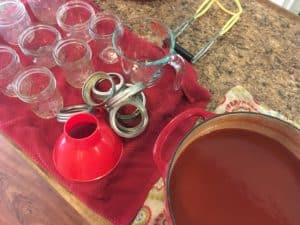 Ketchup, for example! Also, the full-fat versions of salad dressings include less sugar than the “reduced” fat alternatives. This is why I make lots of my own sauces (ketchup, mustard, salsa, spaghetti sauce, etc.) When you make condiments and salad dressings at home, you can flavor with herbs and spices, mustard, vinegar, etc. while lightening up the sugar.
Ketchup, for example! Also, the full-fat versions of salad dressings include less sugar than the “reduced” fat alternatives. This is why I make lots of my own sauces (ketchup, mustard, salsa, spaghetti sauce, etc.) When you make condiments and salad dressings at home, you can flavor with herbs and spices, mustard, vinegar, etc. while lightening up the sugar.
Snacks
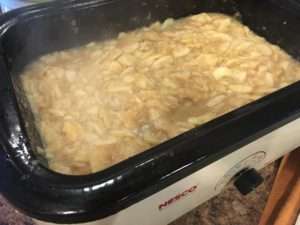 Even “healthy” snacks often have more added sugar than they need. Consider making your own granola bars at home. Applesauce is also very easy to make at home, and the right varieties of apples are naturally sweet that you don’t have to add much (if any) sugar to your sauce.
Even “healthy” snacks often have more added sugar than they need. Consider making your own granola bars at home. Applesauce is also very easy to make at home, and the right varieties of apples are naturally sweet that you don’t have to add much (if any) sugar to your sauce.
One thing that ends up with quite a bit of sugar added to it is flavored yogurt. Next time you are shopping, take a peek at your favorite flavored yogurt versus the plain yogurt of the same brand. It’s crazy the difference! I started buying plain yogurt and just stir a bit of my homemade jam into it when I eat it.
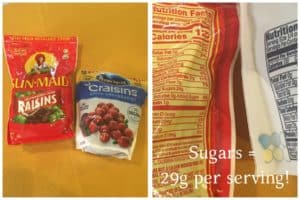 One thing to be cautious of is dried fruit. Dehydrated fruit contains the same amount of sugar that fresh fruit does, but it’s easier to eat a few handfuls of it because of its snack size. Some manufacturers also add extra sugar to it, so again – read your labels.
One thing to be cautious of is dried fruit. Dehydrated fruit contains the same amount of sugar that fresh fruit does, but it’s easier to eat a few handfuls of it because of its snack size. Some manufacturers also add extra sugar to it, so again – read your labels.
Some labels are also sneaky in that they will say something like “contains real fruit” on the front like it’s a really healthy thing you are buying. But, when you read the actual label it will disclose that it’s “10% fruit” – and likely the first ingredient is corn syrup.
It’s pretty easy to dehydrate your own fruit at home, too. My favorite thing to dehydrate is banana chips.
Homemade Baked Goods
In most baked goods (like cake, quick bread, muffins), you can reduce the amount of sugar used in the recipe. That recipe for your grandma’s banana bread? Try it with half as much sugar next time, and see if you notice. Even if a recipe calls for 2 cups of sugar and you use 1/2 cup less – that’s still 1/2 cup less sugar for your family. Give it a try and see what you think.
I’m not a baker, but there are also cookbooks out there like this one, where people have already done the experimenting for us and put them in a nice book to share with the world.
Low-Sugar Jams
I make a lot of homemade jam, and I always make it low-sugar by using Pomona’s Pectin. They have a lot of recipes on their website, and they have a really great cookbook too. Most of their recipes use at least half or less sugar than traditional jam recipes. You actually can make jam with NO added sugar by using this pectin.
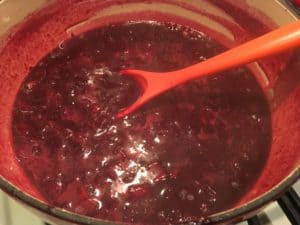 In our house, we have actually gotten to where if we eat a regular full-sugar jam, we don’t even care for it because it’s too sweet for us. So – you CAN alter your taste buds away from all that sugar!
In our house, we have actually gotten to where if we eat a regular full-sugar jam, we don’t even care for it because it’s too sweet for us. So – you CAN alter your taste buds away from all that sugar!
Note that for other canning recipes too, altering the amount of sugar in a recipe does not affect the safety. So, while following approved recipes when canning is important – you can always safely reduce the amount of sugar used as you wish.
Alternatively, this Naturally Sweet Food in Jars features a variety of preserves you can make using unrefined sugars and fruit juices.
If you are buying jam at the store, note the labels. If it’s labeled “sugar-free” – it likely means it has artificial sweetener in it, not that it’s without sugar. It all comes back to reading those labels!
Seasonings
Adding seasonings like cinnamon, mint, vanilla extract, dark cocoa powder, and ginger are great ways to add flavor to drinks and foods – without adding sugar. For example, my husband and I love grapefruit with cinnamon on it. Mint adds a nice sweet flavor to tea, cocoa powder in oatmeal, and vanilla extract to plain yogurt. You get the idea!
Reduce Sugar Intake by Starting Gradually
As you can see, there are lots of ways you can reduce your sugar intake. I think the easiest way to start reducing your sugar intake is to start by cutting sugar gradually.
For example, do you drink sweet tea? Start by drinking half sweet / half unsweet and gradually adjust your ratio to be more unsweet. Eventually, a full glass of unsweetened tea will taste just right to you. Other examples would be 1/2 teaspoon of sugar in your coffee instead of 1 full teaspoon or one drizzle of maple syrup on your pancakes instead of two.
However you are currently consuming sugar, just get started by consuming less in small ways. Over time, it will be easier to eat less and less sugar, and you won’t even notice it. I promise!
Resources:
- https://www.healthdesigns.net/natural-vs-refined-sugar/
- https://www.healthline.com/nutrition/14-ways-to-eat-less-sugar
- https://newspunch.com/high-fructose-corn-syrup-renamed/
- https://www.heart.org/en/healthy-living/healthy-eating/eat-smart/sugar/sugar-101
- https://www.cancercenter.com/community/blog/2016/08/natural-vs-refined-sugars-what-is-the-difference
- https://www.9healthfair.org/blog/total-sugars-vs-added-sugar-need-know
- https://www.goodlifetea.com/blogs/news/refined-vs-unrefined-sugar-for-tea
- https://www.health.harvard.edu/blog/artificial-sweeteners-sugar-free-but-at-what-cost-201207165030

